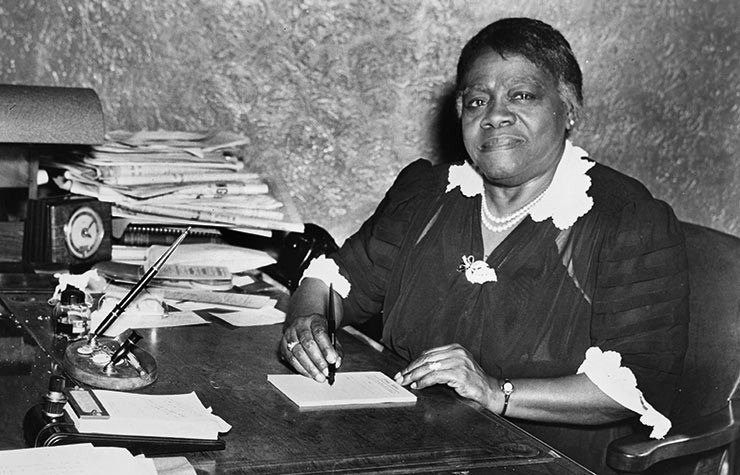Mrs. Mary McLeod Bethune was the first Black woman to head a federal agency, National Youth Administration. She was the founder of Bethune Cookman College and held many important government positions under Presidents Coolidge, Hoover, Roosevelt and Truman.
by Sharon W. Foxworth
Born shortly after the Emancipation Proclamation, Mary McLeod Bethune was the first of seventeen siblings born free. This first was only one of many that she would accomplish in her lifetime. Proclaimed by her mother and neighbors as different from birth, Mary was said to be born with her eyes open; she was known to see things before they happened. Her vision and singlemindeness in the pursuit of educational opportunities for Black youth is testament to her accomplishments. With five students and less than $2.00 Mary Mcleod Bethune started the Daytona Normal and Industrial School for Negro Girls in Daytona Beach, Florida in 1904. Today this institution educates several hundred Black students each year.
Young Mary’s education was rooted in a family tradition that demanded commitment to God and family. Her parents, Samuel and Patsy McLeod, were born as slaves on nearby plantations in Mayesville, South Carolina. Slaves were not usually permitted to choose their spouses. However, when Samuel McLeod sought permission from Patsy’s master to marry her he was granted permission with the stipulation that he first buy her. A slave himself, he spent every spare moment working to earn money to purchase Patsy’s freedom. Although most of their children were sold into slavery, Patsy and Samuel McLeod were able to keep track of them through a secret slave network that sent messages from plantation to plantation. Following the Civil War the entire family was reunited.
With 5 students and less than $2. Mary Mcleod Bethune started the Daytona Norman and Industrial School for Black Women in Daytona Beach Florida.
Mary worked side by side with her mother and father to farm their five acre tract of land. At the age of nine she could pick 250 pounds of cotton a day. Like her strength, her desire for learning was evident at a young age. In 1882 educational opportunities for Black children were scarce. In this post-reconstruction period, there were many who believed that Blacks could not learn and others who were against the education of Blacks, fearing that they would become discontent with subservient roles.
It was on one of those days, while working alongside her family that Mary learned her formal education was about to begin. Emma Wilson, a Black educator and missionary was starting a school for young Black girls in the Trinity Presbyterian Church in Mayesville, South Carolina. Mary’s parents decided she would be the one child of theirs to go. Mary McLeod walked ten miles back and forth to school each day for six years.
With a scholarship from a northern white benefactor up north, Mary entered Scotia Seminary for Negro Girls in 1887. Her dream was to be a missionary to Africa. One of her greatest disappointments was when her application was denied by the Presbyterian Board of Missions, which stated that there were no opportunities for Black missionaries in Africa. As fate would have it, her missionary training would fare her well. Rejected by the Presbyterian Board of Missions, Mary returned to Mayesville and taught in the school where her own formal education had begun. McLeod was offered an opportunity to teach in Augusta, Georgia under the direction of Lucy Croft Laney.
Lucy Laney, a former slave, had graduated in the first class of Atlanta University in 1873. Atlanta University was one of only a dozen Black colleges in existence at the time. A renowned educator, Lucy Laney had founded the Haines Normal and Industrial Institute. McLeod was greatly influenced by Lucy Laney. It was during her stay in Augusta, that McLeod resolved that “Africans in America needed learning and Christ just as much as Negroes in Africa.” She married Albertus Bethune in 1898 and began a life-long struggle to insure access to equal education for Black children.
Bethune once dreamed that Booker T. Washington, founder of the Tuskegee Institute, gave her a diamond to help her found a school. With this inspiration, Bethune opened the doors of the Daytona Normal and Industrial School for Girls in October, 1904. There was much debate among Blacks at the time about the virtue of industrial education. Many believed that industrial education simply prepared Blacks to continue in menial jobs.
Mary McLeod Bethune argued that even the most menial of jobs could be confronted with dignity. Like Washington, Bethune believed that her people needed a basic education and skills for survival. She also believed that industrial education was the key to economic freedom and self sufficiency for black people. But her vision for Black children did not end with industrial education. She also shared the opinion of W.E.B. DuBois that there should be no limit on the educational and social attainment of Black Americans. After graduating her first class Bethune went on to establish a high school for young Black girls.
She fought constantly to keep the doors of her school open. Her greatest problem was a lack of money. She had opened the school with contributions from the community and with money raised from selling pies and ice cream. But Bethune knew that to sustain the school and to expand she would need large contributions and the support of foundations. To this end, she proved to be an astute businesswoman and superior fundraiser. She formed a choir with her students and gave performances to raise money. Bethune also solicited the wealthy vacationers in Daytona’s resorts and hotels.
When one of Bethune’s students became violently ill, she took her to the nearest hospital. She convinced the staff of Dr. C.C. Bahannin’s hospital to admit the child in spite of their policy to admit Whites only. Having been denied permission to visit her student, Bethune managed to gain entrance to the hospital only to discover that her student had been left on the hospital porch unattended. Her anger compelled her to act. In 1911, she opened the first Black hospital in Daytona Beach on the grounds of her school.
On one occasion she presented a performance to a rather small audience and expected to receive very little. At the end of the session a gentleman approached her and gave her a $20 bill. This same gentleman appeared on the campus the next day and requested a tour. When he saw what Bethune had created with materials from the city dump bare determination, he was impressed with her resourcefulness and tenacity. The next day he returned with a new sewing machine for her class and clothing for the students. The gentleman was Thomas White of White Sewing Machine, a major competitor at the time of the Singer Sewing Machine Company. He later returned with carpenters and plasterers who finished Faith Hall, the first building on the campus of the Daytona Normal and Industrial School. When Bethune attempted to thank him, he admonished her and said “I have never invested a dollar that has brought greater returns than the dollars I’ve given you.” Thomas White became a major benefactor of the school. It was he who worked with entrepreneur James Gamble to buy The Retreat, a small building behind Faith Hall which became Bethune’s permanent residence.
In response to a growing number of male students, the Daytona Normal and Industrial School changed to Daytona Institute. The school continued to grow and was soon accredited as a full liberal arts college by the state of Florida in 1923. The school merged with Cookman Institute, a school for boys that had been started under the auspices of the Freedmans Bureau. The Freedmans Bureau was instituted by the federal government to aid former slaves after the Civil War. Mary Mecleod Bethume served as president of what is now called Bethume-Cookman college until 1943.
While she is heralded for her achievements in education, Mary McLeod Bethune’s vision for Black America reached into many segments of society. When one of Bethune’s students became violently ill, she took her to the nearest hospital. She convinced the staff of Dr. C.C. Bahannin’s hospital to admit the child in spite of their policy to admit Whites only. After being denied permission to visit her student, Bethune managed to gain entrance to the hospital only to discover that her student had been left on the hospital porch unattended. Bethune’s anger propelled her to action. In 1911, she opened the first Black hospital in Daytona Beach on the grounds of her school. Deeply committed to the cause of Black women, Bethune founded the National Council on Black Women in 1935. Bethune believed that the Black women were pivotal to the improvement of the Black race. It was her belief that while advances made among women at that time had prepared them to play a critical role, Black women also lacked organization. The National Council on Negro women sought to oversee all of the Black women’s clubs and organizations.
Bethune worked in the American relief organization, and fought the Red Cross’ policy of segregation. Shortly after the start of World War I, she was invited to Washington, D.C. by Vice President Thomas Marshall to discuss the issue of segregation. Bethune’s arguments for integrated forces in the Red Cross were so impressive that he sent her across the country to speak about the need for Blacks to serve in the Red Cross. Presidents Coolidge and Hoover called upon her to provide direction to the cause of education for Black children. President Roosevelt appointed Bethune to the position of Director, Division of Black Affairs, National Youth Administration. She was the first Black woman in American history to be appointed to a head a federal agency.
In 1935, Bethune received the prestigious Spingarn Medal. The award was established by the NAACP to honor “the highest or noblest achievement by a Negro.” Mary McLeod Bethune’s contribution to Black America were indeed great. Her efforts toward the full inclusion of Black children are unparalleled. True to her calling to become a missionary, Bethune’s service went far beyond her life’s work.

